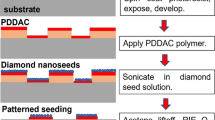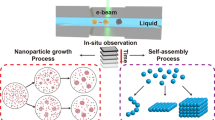Abstract
Methods to align one-dimensional microstructures composed of organic materials have attracted much attention because of their potential applications to devices such as field-effect transistors. Although dip coating is one of the methods (using self-assembly) used for the purpose, its disadvantage is that a larger amount of the material dissolves in the solution than what actually gets deposited on substrate. In this study, we developed a novel method that requires a small amount of precursor solution. By placing a polydimethylsiloxane block on a glass substrate and rotating the substrate using a spin coater, a small amount of the precursor solution was confined in a narrow region along the foot of the block. When we used an organic semiconducting material, 9,10-dibromoanthracene, as a solute, aligned and roughly oriented crystalline needles were precipitated. The thicknesses and lengths of the crystalline needles were controlled by the composition of the solvent and the rotation speed.















Similar content being viewed by others
References
Su B, Wu Y and Jiang L 2012 Chem. Soc. Rev. 41 7832
Tang Q, Jiang L, Tong Y, Li H, Liu Y, Wang Z et al 2008 Adv. Mater. 20 2947
Zhang X, Lu M, Zhang Y, Chen L and Wang Z L 2009 Adv. Mater. 21 2767
Pu D, Zhou W, Li Y, Chen J, Chen J, Zhang H et al 2015 RSC Adv. 5 100725
Jamal M, Xu J and Razeeb K M 2010 Biosens. Bioelectron. 26 1420
Tang Q, Li H, He M, Hu W, Liu C, Chen K et al 2006 Adv. Mater. 18 65
Huang J, Fan R, Connor S and Yang P 2007 Angew. Chem. Int. Ed. 46 2414
Nam S, Jang J, Anthony J E, Park J, Park C E and Kim K 2013 ACS Appl. Mater. Interfaces 5 2146
Liu S, Wang W M, Mannsfeld S C B, Locklin J, Erk P, Gomez M et al 2007 Langmuir 23 7428
Hong S W, Byun M and Lin Z 2009 Angew. Chem. Int. Ed. 48 512
Messer B, Song J H and Yang P 2000 J Am. Chem. Soc. 122 10232
Tong Y, Tang Q, Lemke H T, Moth-Poulsen K, Westerlund F, Hammershoj P et al 2010 Langmuir 26 1130
Li H, Tee B C, Cha J J, Cui Y, Chung J W, Lee S Y et al 2012 J. Am. Chem. Soc. 134 2760
Deegan R D, Bakajin O, Dupont T F, Huber G, Nagel S R and Witten T A 1997 Nature 389 827
Hu H and Larson R G 2006 J. Phys. Chem. B 110 7090
Hu H and Larson R G 2002 J. Phys. Chem. B 106 1334
Watanabe S, Fujita T, Ribierre J, Takaishi K, Muto T, Adachi C et al 2016 ACS Appl. Mater. Interfaces 8 17574
Furmidge C G L 1962 J. Colloid Sci. 17 309
de Gennes P, Brochard-Wyart F and Quere D 2004 Capillarity and wetting phenomena (New York: Springer-Verlag) Chapter 2, ISBN0-387-00592-7
de Gennes P, Brochard-Wyart F and Quere D 2004 Capillarity and wetting phenomena (New York: Springer-Verlag) Chapter 9, ISBN0-387-00592-7
Shanmuganathan K, Fang Y, Chou D Y, Sparks S, Hibbert J and Ellison C J 2012 ACS Macro Lett. 1 960
Author information
Authors and Affiliations
Corresponding author
Rights and permissions
About this article
Cite this article
Watanabe, M., Tanaka, K. Facile method to align crystalline needles composed of organic semiconducting materials using a balance between centrifugal and capillary forces. Bull Mater Sci 40, 1127–1136 (2017). https://doi.org/10.1007/s12034-017-1476-z
Received:
Accepted:
Published:
Issue Date:
DOI: https://doi.org/10.1007/s12034-017-1476-z




